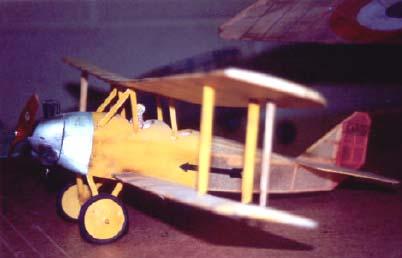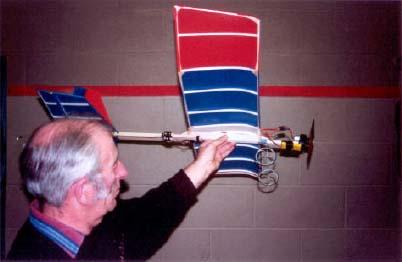|
 
Indoor Experience
by Trevor Hewson with photographs by Mike Roach
(An article published in the March 2001 edition of Sloping Off)

Beautiful freeflight Kinear Canary by Colin Cousins
Since the previous edition of Sloping Off, we have held further indoor sessions at each of the two local sports centres. This article is intended to give you some idea of the fun to be had, and also to capture some of the lessons learned, in the hope of encouraging you to take the plunge into the warm, dry and highly entertaining world of indoor flying.
Perhaps the first lesson is that it doesn't have to be radio controlled to be fun. Indoor freeflight (mainly rubber powered, but some CO2) has been a popular, if minority, sport since before r/c came along. Now the r/c community is venturing indoors, many of us are re-discovering the simple pleasures of watching a well-trimmed rubber powered model gently circle up towards the ceiling, level out and then work its way down again. Such pleasure can be yours for the sum £7.50 by the purchase of the Ikara Butterfly. This remarkable beauty comes in RTF form - and I mean RTF not ARTF - just tie a knot in the elastic, wind it up and let it go. I managed three laps of my dining room in the four feet of air space between the heads of the assembled committee meeting and the ceiling, neatly circling the central light fitting. Guess what? they all wanted one!
The Butterfly is available from Flitehook in Southampton (023 8086154). John and Pauline are very helpful and even came along to support our indoor sessions, where several more Butterflies were purchased, so you can expect to see plenty of them at our Stanpit Main Hall meetings and Gordon is busy devising some fun comps for them next season.
The more expert end of indoor free flight has been demonstrated at our meetings by friends from the Bournemouth club and from Southampton. Some of the models need to be seen to be believed, ranging from the ultra lightweight, ultra slow endurance type to a wonderful scale Flying Flea which takes off, flies racing circles the full width of the hall followed by a perfect landing, never rising more than three feet off the ground!
Whilst the indoor free flighters probably have an average of 20 years experience apiece behind them (double that in a few cases!), the same cannot be said for the indoor r/c brigade - and it shows! As the Chairman put it after our first session "We are all on a steep learning curve." Since he was at the time in the process of stowing the remains of his model, which I had crashed for him on its test flight, I could only agree! Some of the lessons learned about the more common models to date are:
Pico Stik
This is terrific value, particularly the all-in deals. It will fly on 6 cells, but is better on 7 or 8. Its main drawback is its limited 'turnability'. Built exactly as per instructions, it is possible to fly circuits and figure 8s in a standard sports hall (four Badminton courts), but if you fly down the middle of the hall you are doomed! There are modifications that can be made which improve the turning circle, essentially by increasing the dihedral.
Ikarus Bleriot
Phil has been flying this model very successfully. In spite of being larger than the Pico Stik, it does turn more tightly. It is though a good bit more expensive. Phil has not yet demonstrated whether it crashes well.
IFO / Mini IFO
These are designed as stunt aircraft and will turn in little more than their own length - horizontally or vertically! The Mini IFO can be a bit of a handful, since one twitch of the thumb and you can find yourself prop hanging (I know, I was that (very surprised) pilot!). However, Jim's not-quite-standard version seems very stable, and it may be that with a forward cg and modest power, this could be a viable first indoor model for an aileron certificated pilot. Its main advantage as a trainer is its unrivalled bounceability. I have piled mine in several times and all that happens is that the motor falls off. It is a matter of moments to cyano it back on (see pop-off motor, if you can't even wait for the cyano to set!) In a really heavy (read vertical) impact, the gearbox can also sustain damage, but the airframe seems totally crashproof.
Ikarus Piccolo
This diminutive helicopter flies well and, for a helicopter, is quite robust. No problem staying within the limits of the walls - but you do need to be able to fly a helicopter.
Roll Your Own?
 The surprise of our recent meeting (especially to Brian) was his own design model, pictured above. This is bigger than the Pico Stik and has a heavily cambered wing with generous tip dihedral. It is very stately in flight and has a remarkably good turning response. As a result there is plenty of time to work out how to avoid the next wall. No aerobatics, but just the thing for building a bit of indoor confidence. Talk to Brian if you want to do a copy - I don't believe any of the dimensions are critical, just keep it light. The surprise of our recent meeting (especially to Brian) was his own design model, pictured above. This is bigger than the Pico Stik and has a heavily cambered wing with generous tip dihedral. It is very stately in flight and has a remarkably good turning response. As a result there is plenty of time to work out how to avoid the next wall. No aerobatics, but just the thing for building a bit of indoor confidence. Talk to Brian if you want to do a copy - I don't believe any of the dimensions are critical, just keep it light.
My thanks to Mike Roach, who took the photos, and if you want to get a feel for the action, Brian shot some video which, when I have had a chance to censor my crashes out of it, will probably appear at a forthcoming club night.
As we said last time, these indoor sessions are being arranged on a rather ad hoc basis at present and we can't publish a programme three months in advance. If you want to join in you will be made very welcome and, as always, there will be plenty of help on hand. The only thing you have to do is choose your model and make a phone call to find out when and where the next session will be - If you don't call us, we won't call you!
(For enquiries about club membership, see Christchurch & District Model Flying Club)
 
|
|

